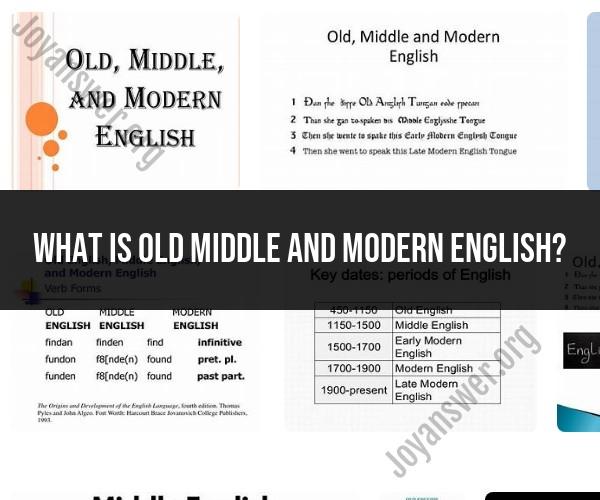What is old middle and modern English?
The evolution of the English language can be divided into three major periods: Old English, Middle English, and Modern English. Each of these stages represents distinct linguistic and historical eras with significant changes in vocabulary, grammar, and pronunciation.
Old English (ca. 450-1150 CE):
- Old English, also known as Anglo-Saxon, was spoken in what is now modern-day England and southern Scotland from roughly the mid-5th century until the mid-12th century.
- It was heavily influenced by the Germanic languages brought to Britain by the Anglo-Saxon settlers.
- Old English is characterized by its complex inflectional grammar, which included a system of noun declensions and verb conjugations.
- The vocabulary of Old English included words derived from Germanic roots, Old Norse, Latin (due to Christianization), and Celtic languages.
- Written records from this period include epic poems like "Beowulf" and religious texts like the "Anglo-Saxon Chronicle."
Middle English (ca. 1150-1500 CE):
- Middle English developed after the Norman Conquest of England in 1066 when Norman French and Old English merged, leading to significant linguistic changes.
- During this period, English evolved into a more analytic language with simplified grammar compared to Old English.
- The vocabulary expanded significantly with the influence of Norman French, Latin (especially through ecclesiastical sources), and other languages.
- The emergence of dialects marked Middle English, with regional variations in vocabulary, pronunciation, and grammar.
- Geoffrey Chaucer's "The Canterbury Tales" is one of the most famous literary works from this era.
Modern English (ca. 1500-present):
- Modern English began around the late 15th century and continues to the present day.
- It was marked by the Renaissance, which brought an influx of Latin and Greek words into English.
- The printing press, introduced by William Caxton in 1476, played a significant role in standardizing and spreading the language.
- The vocabulary continued to grow through contact with other languages during the age of exploration and colonialism.
- The Great Vowel Shift (15th to 18th century) led to significant changes in pronunciation.
- Modern English is characterized by a simplified grammar, a fixed word order, and a rich and varied vocabulary influenced by Latin, Greek, French, and other languages.
- Prominent authors such as William Shakespeare, Jane Austen, Charles Dickens, and countless others contributed to the development of Modern English literature.
Modern English is further divided into Early Modern English (late 15th to late 17th century) and Late Modern English (late 17th century to the present), with ongoing vocabulary expansion and adaptation to changing social and technological contexts. Today's English continues to evolve, with global influences from technology, media, and international communication shaping the language in new ways.
The Evolution of English: From Old to Middle to Modern
English is a West Germanic language that has evolved over centuries. It is the third most widely spoken language in the world, with over 1.5 billion speakers. The evolution of English can be divided into three main periods: Old English, Middle English, and Modern English.
Old English
Old English was spoken in England from the 5th to the 11th centuries. It was brought to England by the Anglo-Saxon invaders from northern Germany and southern Denmark. Old English was a very different language from Modern English. It had a more complex grammar and a different vocabulary.
Some examples of Old English words include:
- mann (man)
- wif (woman)
- hūs (house)
- hund (dog)
- stān (stone)
Middle English
Middle English was spoken in England from the 11th to the 15th centuries. It developed after the Norman Conquest of 1066. The Normans brought with them their own language, French, which had a significant influence on Middle English. Middle English was a more simplified language than Old English. It had a simpler grammar and a more diverse vocabulary.
Some examples of Middle English words include:
- man (man)
- woman (woman)
- house (house)
- dog (dog)
- stone (stone)
Modern English
Modern English began to develop in the 16th century. It was influenced by a number of factors, including the Renaissance, the Protestant Reformation, and the invention of the printing press. Modern English is the most simplified form of English. It has a relatively simple grammar and a very diverse vocabulary.
Some examples of Modern English words include:
- man (man)
- woman (woman)
- house (house)
- dog (dog)
- stone (stone)
Conclusion
The evolution of English is a fascinating story. The language has changed dramatically over the centuries, but it has retained its core identity as a West Germanic language. English is a vibrant and dynamic language that continues to evolve to this day.
Old, Middle, and Modern English: Tracing the Language's Development
The development of English from Old to Middle to Modern can be traced through a number of key changes in grammar, vocabulary, and pronunciation.
Grammar
Old English had a more complex grammar than Middle English or Modern English. For example, Old English had four noun genders (masculine, feminine, neuter, and common), while Middle English had three genders (masculine, feminine, and neuter), and Modern English has only two genders (common and neuter). Old English also had a more complex system of verb conjugations than Middle English or Modern English.
Vocabulary
The vocabulary of English has changed significantly over time. Old English was influenced by Old Norse and Old Irish, while Middle English was influenced by French and Latin. Modern English has been influenced by a wide variety of languages, including French, Latin, Greek, Spanish, and Hindi.
Pronunciation
The pronunciation of English has also changed significantly over time. For example, the Old English word hūs (house) was pronounced with a long oo sound, while the Modern English word house is pronounced with a short ow sound.
Here are some specific examples of how English has changed from Old to Middle to Modern:
Old English:
- Ic eom mann. (I am a man.)
- Ic lufoge þē. (I love you.)
- Hūs is micel. (The house is big.)
Middle English:
- I am a man.
- I love thee.
- The hous is greet.
Modern English:
- I am a man.
- I love you.
- The house is big.
Language Through Time: The Journey from Old English to Modern English
The journey of English from Old to Middle to Modern has been a long and complex one. The language has been influenced by a wide variety of factors, including contact with other languages, social and cultural changes, and technological advancements.
One of the most significant changes in the English language occurred after the Norman Conquest of 1066. The Normans brought with them their own language, French, which had a significant impact on the development of English. Many French words were borrowed into English, and the grammar of English was simplified.
Another major change in the English language occurred in the 16th century, during the Renaissance. The Renaissance was a period of renewed interest in classical learning, and many Latin and Greek words were borrowed into English







